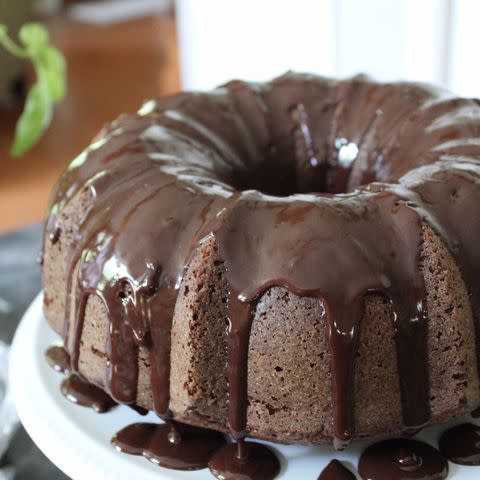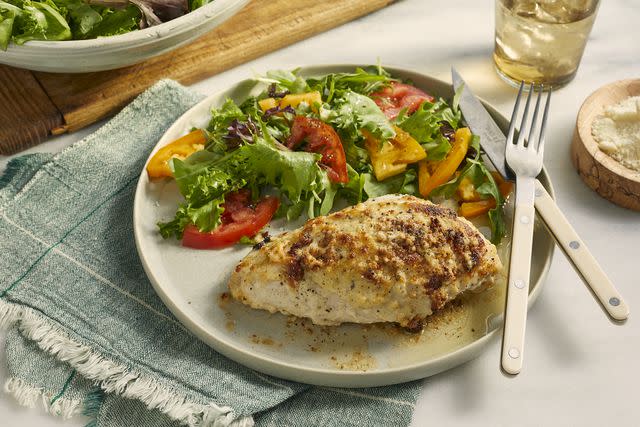Our Guide to Mayonnaise Will Help You Master Shortcut Cooking
How to use mayonnaise to make incredible sweet and savory dishes.

Mayonnaise is by far the most popular condiment in the US. The sheer amount of uses from its un-doctored state right out of the jar or as an ingredient in cooking or baking is unmatched. Ketchup in a cake? I don't think so. But mayo? Absolutely. And that very same jar can be spooned into later to crust some chicken for the family dinner.
So, what exactly is this substance that flies off the shelves by the hundreds of millions each year and shows up in everything from pastries to pastrami sandwiches?
Related: Why Do People Hate Mayonnaise?
What Is Mayonnaise?
Mayonnaise is magic. It takes three simple ingredients – oil, eggs, and acid – and transforms them into a beautifully whipped, opaque white sauce. More scientifically, it's an emulsion, which is defined as a successful combination – specifically a suspension – of two things that don't mix, like oil and water. In the case of mayo, the oil is, well, oil and the "water" is egg yolks. It's technically speaking the fattiest emulsion of its kind, which I think is kind of cool (and certainly kind of delicious).
Origins of Mayonnaise
The US might win the title of most mayo purchased and consumed, but it didn't come from here. France gets that accolade.
The story goes that the chef of Duke de Richelieu's created the sauce by blending oil with egg in 1756 during a battle with the British in the Port of Mahon on Menorca. The intent was a cream-based sauce, but the kitchen was out of dairy, so he turned to oil to provide the fattiness. The chef called the sauce "mahonnaise" as a celebration of the Duke's victory there.
Later, Chef G. Auguste Escoffier, the culinary legend, wrote in his 'Le Guide Culinaire' of 1903 that mayonnaise was the mother of all cold sauces, a statement that honors the creation of tartar, thousand island, and remoulade. It's also no surprise it has such versatility and popularity today.

Get the recipe: Chocolate Mayonnaise Cake
What Does Mayonnaise Taste Like?
On its own, mayonnaise is tangy, with a custard-like texture, and smooth and creamy consistency. Store-bought brands have a bit more pungency to their smell and taste, whereas homemade mayo is fresher and cleaner on the palate.
Despite its raging popularity, there are still plenty of mayo-haters. But the range of uses go far beyond the smear on a sandwich or the dip of a French fry. Being oil-based, mayonnaise adds the perfect fat to all sorts of dishes, and if open to it, it would be hard not to discover at least ONE thing to like.
Mayonnaise vs. Miracle Whip
Many people are firmly team mayo or team Miracle Whip. There are many differences between the two, which you can read about here.
Mostly, the distinctions come down to ingredients – mayo having just three basic (eggs, oil, and acid) and Miracle Whip using less oil and adding water, sugar, and spices like mustard, paprika, and garlic. Miracle Whip is also labeled "dressing," since anything labeled "mayonnaise" must be at least 65% vegetable oil by weight. Finally, Miracle Whip is sweeter, and this statement includes brands of mayonnaise that add sugar, like Hellmann's.
Related: Mayonnaise vs. Miracle Whip: What’s the Difference?
How to Cook with Mayonnaise
Reach for the cold, creamy condiment to bind together a chilled salad like pasta, potato, or egg or a quick coleslaw. Use it to tame a hot sauce like sriracha to make a rich and flavorful spread for sandwiches or a pairing for crispy French fries. Toss it in a marinade or use it to coat chicken or fish before pan-searing or baking.
Mayonnaise adds a wonderful richness to cakes, cookies, or even biscuits.
We all know the classic smear of mayo inside a turkey sandwich or BLT, but also try spreading it on the outside of the bread before searing a grilled cheese to create the perfect crust.

Get the recipe: Mayo Chicken
How to Make Mayonnaise from Scratch
Making mayonnaise from home is surprisingly easy and once you taste the difference in freshness, you may never go back. Simply use a stand mixer with a whisk attachment or food processor and let the machines do the work.
Related: How to Make Homemade Mayonnaise
This recipe uses a whisk and involves simply combining egg yolks and lemon juice, then slowly streaming in oil until it comes together.
How to Store Mayonnaise
Mayonnaise is a surprisingly shelf-stable product – when unopened, that is. This is because manufactured products utilize pasteurized eggs and stabilizers, not to mention the acidic nature of the vinegar will keep bacterial growth at bay. Once opened, it should be refrigerated, but it'll still last quite a long time behind the doors of that fridge for 2 months or more.
If you're making it at home, the only option is the fridge. It'll only last about 3 days, so making large quantities at a time isn't recommended. If it starts to separate, just give it a stir.
Related:
Read the original article on All Recipes.


